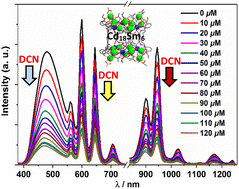A 24-metal Cd(ii)–Sm(iii) nanocage with a rapid triple-emissive response for 2,6-dichloro-4-nitroaniline†
Abstract
A 24-metal Cd(II)–Sm(III) nanocluster [Cd18Sm6L9(OAc)36] (CSN) was constructed from a new flexible Schiff base ligand. It can be used as a probe to detect 2,6-dichloro-4-nitroaniline (DCN, LOD: 0.67–0.75 μM), which is not influenced by the presence of other pesticides. The response behavior of CSN to DCN is expressed using a first-order equation 1/I475nm + 1/I645nm + 1/I945nm = A[DCN] + B, and it is used to determine DCN concentrations in the extract of fruits. For example, for the concentration determination of DCN in carrot extract, the ranges of recovery and RSD are 96.11–103.50% and 0.95–4.12%, respectively.

- This article is part of the themed collection: 2023 Inorganic Chemistry Frontiers HOT articles


 Please wait while we load your content...
Please wait while we load your content...